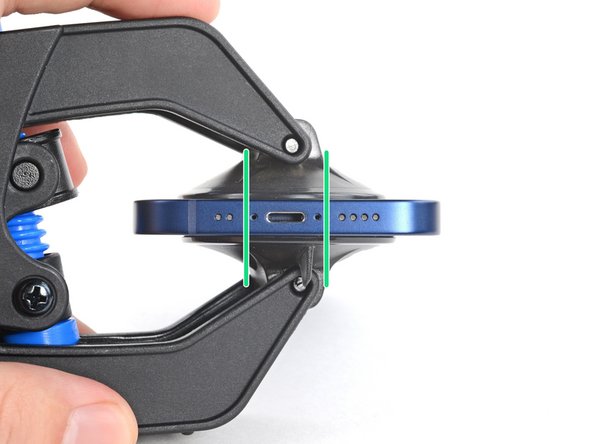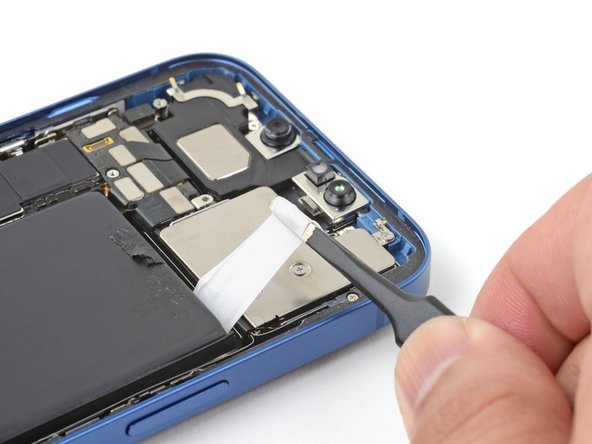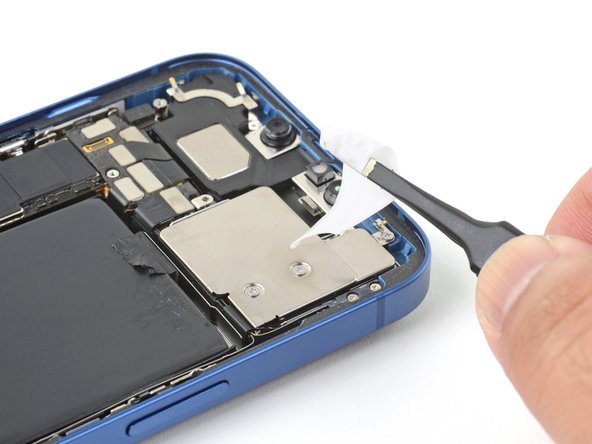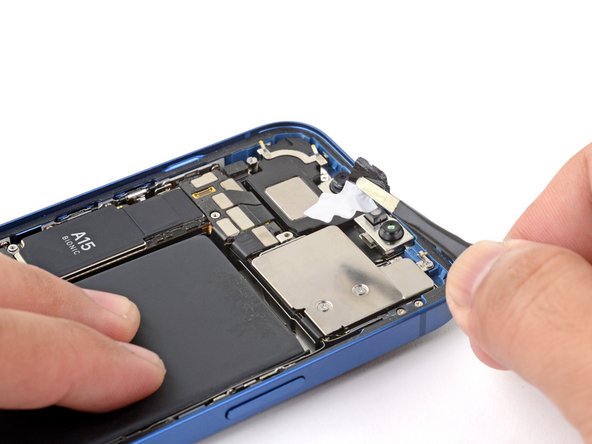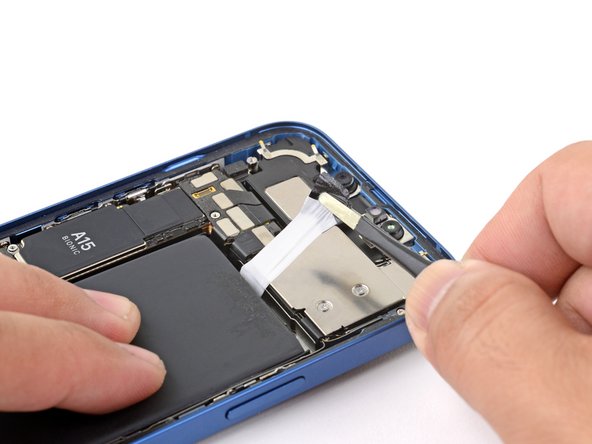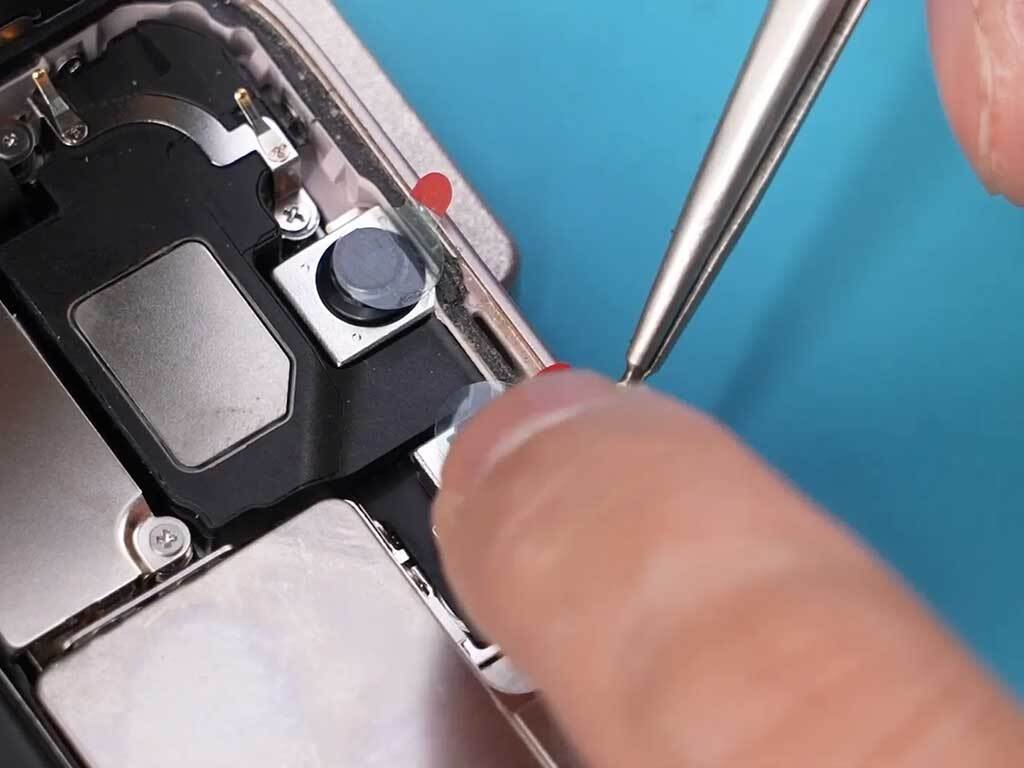iPhone 13 Battery Replacement
Duration: 45 minutes
Steps: 38 Steps
iPhone batteries are designed to keep up with your busy life for about 500 charge cycles (that’s roughly 18-24 months for most folks). After that, you might find yourself hunting for a charger more often and notice your phone slowing down. This guide walks you through swapping out your battery, giving your iPhone a second wind. If your battery looks swollen, be careful and take extra steps to stay safe. Pro tip: Removing the loudspeaker makes it easier to grab those sticky battery adhesive strips, but you can still get the battery out without taking the loudspeaker out first. Heads up—if you’re running iOS 17.6 or earlier, you might see a message about your battery’s ‘genuineness’ after the replacement, even with Apple parts. If everything’s working, you can ignore it. For iOS 18 and up, use Apple’s Repair Assistant to authenticate your new battery. After you finish, help your battery hit its stride: charge to 100%, keep it plugged in for two more hours, then use your phone until it powers down. Charge back up to 100%—and you’re good to go.
Step 1
Heads up: Before diving in, make sure your iPhone battery is below 25% charge. A fully charged lithium-ion battery can be a bit of a firecracker if accidentally punctured, so play it safe!
Once you open up the iPhone’s display, you’re breaking its waterproof seals. Be sure to have replacement seals on hand before continuing, or if you skip replacing them, be extra careful to keep your phone away from any liquid during reassembly.
- First things first, let’s give your iPhone a little break – power it down before diving into the disassembly adventure!
- Now, grab your trusty pentalobe P2 screwdriver and remove those two 6.8 mm screws chilling at the bottom edge of your iPhone. They won’t know what hit them!
Step 2
Pushing your opening pick in too deep can cause damage—let's avoid that! Mark your pick to keep things safe and sound.
Feel free to mark the other corners of your pick with different measurements for extra precision.
Or, stick a coin onto your pick about 3 mm from the tip to create a handy depth guide.
- Take a moment to measure out 3 mm from the tip, then grab a permanent marker and make a little mark on that opening pick. You've got this!
Step 3
Pop on some safety glasses to keep your eyes safe from any sneaky bits of glass that might come loose during the repair.
Got a cracked screen on your iPhone? No worries! To keep things intact and avoid any pesky cuts, just slap some tape over that glass. It's like a hug for your screen!
If you're really in a bind, try supergluing that suction cup to the screen. It's a little DIY magic to help you out!
- Cover the iPhone's screen with overlapping strips of clear packing tape until the entire front is protected.
- If the suction cup refuses to stick in the upcoming steps, no worries! Just fold a sturdy piece of tape (like duct tape) into a little handle and use that to lift the screen instead.
Tools Used
Step 4
The next three steps show how to use the Anti-Clamp, a tool we designed to make opening your device a breeze. If you’re not using the Anti-Clamp, no worries! Just skip ahead three steps to try a different method.
For detailed instructions on how to use the Anti-Clamp, check out this handy guide.
If your iPhone's surface feels a bit too slippery for the Anti-Clamp to get a good grip, just add a little tape to give it some extra stick.
- Give that blue handle a gentle tug backwards to unlock the Anti-Clamp’s arms—like opening the gates to phone-fixing greatness.
- Slide the arms over either the left or right edge of your iPhone—whichever side looks more inviting.
- Set the suction cups near the bottom edge of your iPhone, one on the front and one on the back, like a little phone sandwich.
- Squeeze both cups together so they stick right where you want to work—firm grip, zero drama.
Step 5
- Give the blue handle a gentle tug forward to secure those arms in place. You've got this!
- Now, give that handle a clockwise spin of 360 degrees – or keep going until those cups start to stretch a bit. Nice and easy!
- Keep an eye on those suction cups; they need to stay in sync! If they start to wobble out of line, just loosen them up a tad and bring the arms back together. Teamwork makes the dream work!
Step 6
Take it slow—just a quarter turn at a time, then kick back for a minute before the next move. Patience is your secret weapon here, so let the Anti-Clamp do its thing!
For all the details on how to work your hair dryer like a pro, check out this guide.
If the Anti-Clamp isn't quite opening up the gap you need, don't hesitate to add a bit more heat to the area and give that handle a little twist—just a quarter turn should do the trick!
- Place your iPhone on a sturdy surface like a hardcover book to keep it steady and level. This will make your repair adventure much easier in the steps ahead.
- Grab your trusty hair dryer and warm up the bottom edge of your iPhone. You want it to be just the right temperature—hot enough to feel a bit too warm to touch.
- Take a breather and wait for a minute. This will give the adhesive a moment to loosen up and make space for your next move.
- When the Anti-Clamp creates a nice little gap, slide an opening pick under the screen's plastic bezel. This is your time to shine!
- Feel free to skip the next three steps. You've got this!
Tools Used
Step 7
Keep your hair dryer moving—parking it in one spot can roast your device instead of just fixing it!
- Grab a hair dryer or heat gun and warm up the bottom edge of your iPhone for about 90 seconds. You want it to get nice and toasty, but not so hot that you can’t handle it!
Tools Used
Step 8
- Stick your suction handle near the bottom edge of your phone, but steer clear of getting too close to the very edge of the glass.
Tools Used
Step 9
The screen is held in place by some serious watertight adhesive, so getting that first gap open requires a bit of muscle. If you're struggling to pry it apart, just apply a little more heat and gently wiggle the screen back and forth. This should help loosen the adhesive enough for you to slip in your tool and get things moving.
- Grab that suction cup and give it a steady, confident tug upwards—just enough to open up a little space between the screen and the frame.
- Slide an opening pick into the gap, getting right under the screen's plastic edge.
Step 10
- Grab a hair dryer and give the right edge of your iPhone (the one with the power button) a little heat love for about 90 seconds or until it’s just too hot to comfortably touch. This should loosen things up for the next step!
Tools Used
Step 11
Keep your pick insertion to under 3 mm—going deeper risks messing up those delicate insides!
- Gently slide the opening pick around the bottom right corner of your iPhone to start loosening the adhesive.
- Keep sliding the pick upward along the right edge until you reach the top right corner.
- Leave the pick in place at the top right corner before moving on to the next step.
Step 12
- Grab your trusty hair dryer and give the top edge of your iPhone a warm hug for about 90 seconds, or until it feels just a tad too toasty for your fingers. You'll be all set to move on!
Tools Used
Step 13
Keep your pick to a maximum of 3 mm—going deeper might just poke the top sensors and cause some trouble!
- Gently slide the opening pick around the top right corner of your iPhone to loosen up that stubborn top adhesive.
- Keep the pick resting in the top left corner for now before moving on to the next step.
Step 14
- Grab your hair dryer and warm up the left edge of your iPhone for about 90 seconds, or until the screen feels almost too hot to touch—think fresh pizza right out of the oven.
Tools Used
Step 15
Watch out for the fragile cables snuggled up along the left edge of your iPhone! It’s super tempting to slip your pick in there, but resist the urge – you don’t want to send those cables packing!
Step 16
Gently twist with a steady hand to loosen things up.
If the adhesive is being stubborn, give the left edge a little extra heat and try again.
- Pop in a second opening pick at the lower left corner of your iPhone. You got this!
- Give both picks a gentle twist at the same time until that left edge clips let loose. Easy peasy!
Step 17
Hold up—don’t yank the display off just yet! There are some delicate ribbon cables still keeping it connected to the iPhone’s logic board.
- If your suction handle is still hanging around, go ahead and take it off now.
- Turn your iPhone so the right edge is facing you.
- Open up the iPhone by swinging the display up from the right side, just like flipping open a book cover.
- Prop the display against something sturdy to keep it steady while you work your magic.
- When putting it back together, place the display in position, line up the clips along the top edge, and gently press that top edge into place before snapping the rest down. If it’s stubborn and won’t click in, double-check the clips around the edges to make sure none are bent or out of shape.
Tools Used
Step 18
Keep an eye on every screw you remove—each one has its own special spot, and mixing them up could give your iPhone a headache.
- Grab your Phillips screwdriver and pop out those three 1.3 mm screws holding down the battery and display connector cover—easy does it!
- When you're putting things back together, it's a smart move to fire up your iPhone and test out all the functions before locking the display down. Just make sure to turn the phone off completely before diving back into the next steps.
Step 19
- Pop off the cover to get started.
Step 20
Be careful not to mess up the black silicone seal around this and other board connections. These little guys are your best friends when it comes to keeping water and dust out, so let's give them some love!
- Grab a spudger or even just a clean fingernail and gently lift the battery connector up from its spot on the logic board.
- Carefully bend the connector a bit away from the board so it doesn’t accidentally touch the socket and zap power back into the phone while you’re working on it.
Tools Used
Step 21
When reconnecting these press connectors, line them up and gently press down one side until you hear a click, then do the same on the other side. Skip pressing in the middle—those pins don’t like surprises and can get bent out of shape. Take your time getting the alignment right to avoid a headache later!
- Gently pry up the display cable connector using a spudger or your fingernail to unplug it with care.
Tools Used
Step 22
- Let's get this party started by removing three screws that are holding the front sensor connector cover in place:
- First up, grab that trusty Phillips screwdriver and tackle the one 1.7 mm screw.
- Next, move on to the slightly smaller 1.3 mm Phillips screw—you're on a roll!
- Finally, finish strong by taking out the 1.8 mm Y000 screw. You're doing great!
Step 23
- Lift the cover from the center of the phone and gently swing it up until that little clip near the edge pops free.
Step 24
- First things first, let's pop off that cover! It’s like peeling off a sticker, but way more satisfying.
- When you’re putting it all back together, start by sliding the clip on the left edge into its cozy little slot. Then, gently hinge the rest of the cover into place like you're tucking in a blanket.
Step 25
- Take your trusty spudger—or just use your fingernail—and gently pop the front sensor assembly cable connector loose.
Tools Used
Step 26
- Let's get that screen off! Once you've done that, take a moment to consider replacing the waterproof adhesive around the edges of the display during reassembly. It's a small step that can make a big difference!
Step 27
- Grab your trusty Phillips driver and get ready to work some magic! It's time to unscrew the four 1.7 mm screws that are holding the loudspeaker in place. You've got this!
Step 28
- Gently take out the loudspeaker from your iPhone.
Step 29
The battery is held in place by four strips of stretchy adhesive—two at the bottom and two at the top. It's like a little hug for your battery!
In the upcoming steps, you'll gently pull on each tab to stretch out that adhesive. These 'command-strip' style adhesives lose their grip when you give them a tug, making battery removal a breeze!
If any of the strips decide to break on you, don’t sweat it! They can be a bit temperamental. Just keep going for some handy tips on dealing with those pesky broken strips.
- Each piece of adhesive has a black pull-tab at the end, which is lightly stuck to the battery edge, ready to be pulled. Gently peel it away when you're ready to remove the battery.
Step 30
Heads up: Avoid poking the battery with anything sharp—trust me, a punctured battery can get messy or even start a fire.
- Grab your trusty spudger and gently lift the edge of the top right battery adhesive pull-tab. Once it's up, use a pair of blunt tweezers to give it a little tug.
- Now, peel down that battery adhesive pull-tab like a pro, un-sticking it from the top edge of the battery.
- Time to tackle the top left battery adhesive pull-tab! Just repeat the process and you're golden.
Step 31
- Gently pull up those last two battery adhesive tabs and free them from the bottom edge of the battery. You got this!
Step 32
If you're feeling fancy, you can tilt the bottom of your phone up and drip a few drops of high-proof (90% or higher) isopropyl alcohol along the bottom edge of the battery. Give it about a minute to work its magic—this loosens up stubborn adhesives, especially on older phones.
Step 33
If one of those sticky strips slips away under the battery and won’t come out, don’t sweat it! Just grab the other strips if you can and keep rolling with the next steps below.
- Catch that little pull-tab at the bottom right with your fingers and gently tug it away from the battery, aiming for the bottom of your iPhone.
- If the adhesive strip decides to break free, no worries! Use your fingers or some blunt tweezers to grab it and keep pulling—just be careful not to pry underneath the battery.
- Pull with enough strength to keep the strip taut, but don’t go overboard. Give it a moment to stretch out and peel away from under the battery.
- Remember, don’t press down on the battery. Hold your iPhone with a good, firm grip on the sides.
- Keep that strip smooth and flat—no wrinkles! Pull evenly across the whole strip instead of just yanking in the middle or on one side.
- Aim for a gentle angle when pulling so the strip glides right off without getting caught on the edge of the battery.
Tools Used
Step 34
If the adhesive rips off under the battery and you can't grab it, no worries — just roll on to the next step!
- Grab the pull-tab at the bottom left with your fingers and gently pull it toward the bottom of the iPhone, away from the battery. Nice and easy!
- If the adhesive strip breaks off, don't panic. Just try to grab it with your fingers or a pair of blunt tweezers and keep pulling. Remember, no prying under the battery—just a steady pull.
- Do the same thing as with the first strip: avoid pressing down on the battery, keep the strip nice and flat without wrinkles, and pull it at a low angle for a smooth finish.
Tools Used
Step 35
For a smoother experience, feel free to wrap those pull-tabs around the tips of your blunt tweezers. It'll make pulling out that pesky adhesive strip a total breeze!
- Just like before, give that top right pull-tab a nice little tug to stretch it out and peel away the adhesive strip. Watch out for any pesky snags along the way!
- Grab a pair of blunt tweezers and make sure to hold onto the full width of that pull-tab for a good grip.
- Now, wrap the pull-tab and adhesive strip around the tips of those tweezers like a pro!
Tools Used
Step 36
Go easy on the battery—no need to give it a squeeze!
- Gently press two fingers on the middle of the battery to keep it from popping out while you deal with the last sticky strip.
- Grab some blunt tweezers and pull on the final tab—stretch it out to free the battery from its adhesive grip.
- If every sticky strip is out of the picture, you can skip the next step.
- If not, keep rolling and check out the next step.
Tools Used
Step 37
Avoid the temptation to pry the battery out with too much force. If it's being stubborn, a couple more drops of alcohol can help soften the adhesive. Remember, no need to squish or poke the battery with your pry tool!
- Still having trouble getting that battery out? No worries! Try dropping a few drops of high-concentration (90% or higher) isopropyl alcohol right under the edge of the battery where the adhesive’s got a grip.
- Now, tilt your phone so the alcohol can make its way to the sticky spots. Gravity’s got your back here.
- Give it a minute to work its magic and loosen up that adhesive. You’ll feel it start to give in.
- Once it’s ready, grab your opening pick or the flat end of a spudger, and gently start lifting the battery out. No rush, just take it slow and steady.
Tools Used
Step 38
- Check out your new replacement part and make sure it matches the original. You might need to swap over some bits or peel off the sticky back on your new part before you get started.
- To put your device back together, just do the steps in reverse—it's like a magic trick!
- Once you're done with your repair, if your new part allows, you can calibrate it with Apple's Repair Assistant, which is ready to roll as of iOS 18. Just update your device, head over to Settings→General→About→Parts & Service History, tap on Restart & Finish Repair, and follow the friendly prompts on your screen.
- Got e-waste? Make sure to drop it off at an R2 or e-Stewards certified recycler!
- If things didn’t go quite as planned, no worries! Try some basic troubleshooting, or if you need a hand, feel free to schedule a repair.















